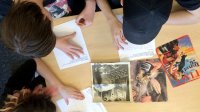Teaching Kids to Argue—Respectfully
Tools and resources for teaching controversial topics and building students’ argumentation skills.
When hot-button issues spill over from social media or the nightly news and into your classroom, what’s the right move as a teacher? Do you shut down arguments about gun control or athletes taking a knee at football games because you fear losing control of the discussion? Or do you look for learning opportunities amid the brouhahas?
Well-facilitated classroom discussions about controversies offer “high-leverage opportunities to help our students hone their critical thinking skills,” says Sox Sperry of Project Look Sharp, a nonprofit at Ithaca College in New York that promotes media literacy.
Yet many teachers aren’t sure how to create a safe space for arguments to play out fairly and respectfully. In a recent Education Week survey, more than half the teachers responding said their training did not prepare them to handle potentially contentious discussions.
“The question isn’t whether we should or shouldn’t teach students to be better thinkers and better citizens,” adds Chris Sperry, who directs curriculum and professional development for Project Look Sharp. “It’s about how do we do it?”
Passionate But Not Personal
Eighth graders at Cary Academy in North Carolina traditionally start the school year with a project on elections that is designed to build their argumentation skills. Teacher Meredith Stewart has students take on the persona of a candidate, campaign manager, or concerned citizen. Then they write a platform statement or their own “vision for America.” The assignment allows them to share their views, “but they have to justify them in a way that’s supported by argument and reason,” the teacher explains.
As the project unfolds, students write persuasive letters, produce TV and radio ads, and engage in forums and debates. The mock election tends to bring up the same issues that are dominating the national news. “It’s a good way for us to get at issues of importance,” Stewart says, “but with students getting support for making their arguments.”
Conducting the project as a simulation “takes the personality piece out of it,” she adds. “You’re not arguing with the person seated next to you, but with a fictional candidate. That doesn’t mean students care any less about their opinions, but it does help them avoid knee-jerk reactions.”
As a history and English teacher who also has degrees in law and theology, Stewart doesn’t shy away from contentious topics. When she sees adults behaving badly—talking over each other on cable news or hurling insults via Twitter—she often holds them up in class as examples of how not to engage in civil discourse.
“Politics has always been nasty,” she reminds students, with plenty of examples of name-calling in previous centuries. “But this feels different. Today we have the signal boost [of social media] and the quickness with which insults can spread.”
If left unchallenged, high-profile examples of name calling or bullying “may leave kids to think this is what discourse should sound like. We need to talk with them about why it’s shocking. What’s not acceptable in our community? We don’t want students to be gaslighted into thinking that this is just the way things are.”
Media Analysis
Media analysis is another strategy to bring controversies into class in a deliberate, nonconfrontational way.
Chris Sperry of Project Look Sharp describes, in broad strokes, how this inquiry-based approach works: He suggests picking a few documents—articles, tweets, video clips—that present different perspectives or points of view about an issue. Guide students through a process of decoding. Get them to ask questions that lead to understanding. What is the message? How is it communicated? Who’s behind this? (This handout suggests more questions to pursue.)
To discuss the NFL controversy, Sox Sperry explains, “we might compare a series of tweets from President Trump, a press release from the NAACP, and a CNN town hall discussion with NFL players, filmmaker Spike Lee, and members of the military. How does each media form help to inform or to mislead the public by its very structure and the intentions of the authors?”
After that initial analysis, “we can move on to a discussion of students understanding their own bias,” Chris Sperry says. “Why do they think one source is more credible than another?” Students are now not only using an academic framework to take apart media messages, “but also analyzing their own judgment, evaluation, and interpretation.”
By reflecting on their own thinking and values, students can recognize the perils of confirmation bias. “Are they only seeking out information that confirms what they already believe?” Chris Sperry points to recent research showing that exposing students to knowledge and facts isn’t enough. Critical thinking is what they need in order to decide what’s true.
To help teachers integrate media analysis across the curriculum and across grade levels, Project Look Sharp has curated hundreds of resources for decoding, along with protocols and other tools to support teachers’ confidence for teaching this way. Project Look Sharp will pilot an online course early next year on how to facilitate challenging topics in the classroom.
More Resources
- Pro/Con: a nonpartisan platform that presents both sides of controversies
- Civil Discourse in the Classroom: a free downloadable guidebook for teachers from Teaching Tolerance
- Socratic Seminar: a structured discussion format in which students learn to listen to each other’s perspectives
